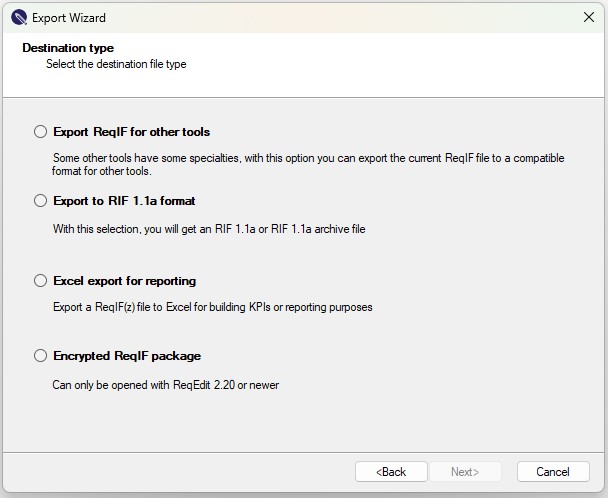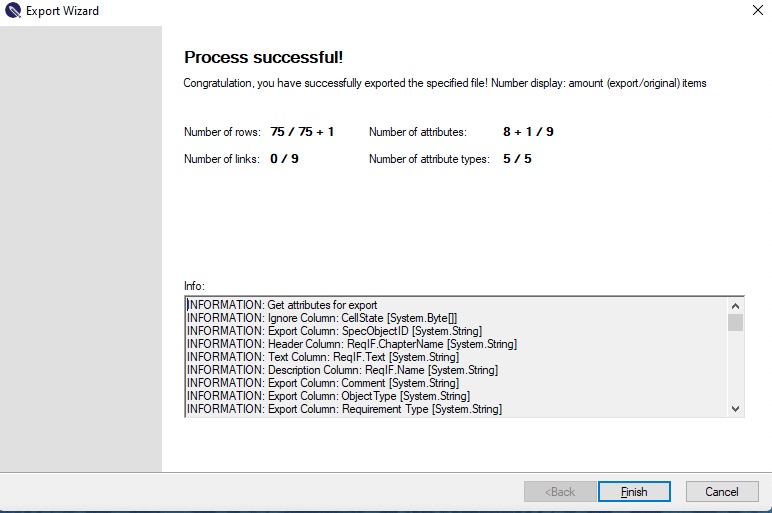Export to MS Excel
4 min read
last updated: 02/02/2024
File types you can export to MS Excel with ReqEdit
- ReqIF 1.0.1 to ReqIF compatibility mode
- RIF 1.1 / RIF 1.1a archive format
- ReqIFz
Use case for export to MS Excel option
Use “Excel Export” if you want use an Excel file for:
- KPI determination
- statistical analysis
- not for reimport changes to ReqIF document
Due to unique column heading ID needed for the export process, the reimported document can present differences in Attribute names. See Result view
Export to MS Excel
- Open the document you want to export from.
- Set the View mode you want in the View menu. It can be predefined or newly set. Export function will export the datas you can see on the screen by the active view mode.
- Open File/ Export…

- Follow Export Wizard
- Choose Excel export for reports in the Wizard Window
- Choose name and location for excel file. The Wizard will generate automatically the ReqIF documents name and adds ‘exported’ as excel file name. It can be modified, if needed.
The export of the ReqIF file will be written in a Excel sheet with the name of the visible document. If the name is longer than 30 characters, it will be shortened to this maximum size supported by Excel. If the user choose an existing excel file the sheet with the exported data will be added or replaced if a sheet with the same name exists.
The message “The file XXX already exists. Do you want to replace it?” generated by the Windows file selector, can be confirmed with “Yes”; only the tab named after the document name will be overwritten entirely.
Note: If you want to export a file with an existing excel file name, close the file before click Start on export to Excel.
- Check the export options boxes (optionally):
- ReqIF formatted text export – Exporting data with formatting (only for text, bold, underlined, strikethrough, italic) Does not support tables, attachments, (limited support of) lists, background colour.
- Add meta information to excel worksheet – Exporting meta info based on the View of the document. It shows the following information in the first rows in the excel worksheet: export date, file name, document name, document ReqIF-ID, view name, user name)

- Finish export. Log info window appear.
- Open the Excel file.

The numbers in the final export wizard window show the amount of hidden attributes (columns) or deleted rows in the original document.
Result export view
If you check Add meta information to the excel worksheet checkbox in the Excel export wizard, the Excel file contains the meta datas in the first rows:

The first 3 columns of the created Excel file contain, independent of the selected View mode:
| Row Nr | Each row is numbered conform to the source specification document. |
| Hierarchy ID | Shows the entry level of the object (text) in the source specification document. The number shows the chapter number it belongs and after the hash sign (#) the entry position in the folder. |
| ObjectReqIF ID | Shows the ReqIF-ID of each object from the source specification document. |
These column headings are reseved for the Excel export. They are important to identify the specifications from the Specification document. If these column names are defined as attributes inside the ReqIF document, the attribute will be reanamed to “ReqEdit.<<atributename>>”. Ex: RowNr -> ReqEdit.RowNr
The name of the tab in the created Excel file are the first 30 characters of the document name.
If you reexport a document to existing Excel file, the final file saves the new version of ReqIF file in the sheet which has the same name. The other sheets /tabs remain the same.
Display of formatted text:
Some elements can be displayed in Excel in a certain mode due to technical limitations:
| Formating | Display | Description |
| Multi Enumeration | multi#1 multi#2 | By default any of the multi valued enumeration values will be displayed separated by a new line. |
| Unordered list | – entry#1 – entry#2 | Any of the unordered lists will be displayed as new line separated entries with an starting dash “-” character for each of the list entries |
| Ordered list | 1. entry#1 2. entry#2 | Any of the ordered list entries will be displayed with a numeric value and followed by a dot |
| Table | [col1][col2] [col1][col2] | Each table column inside of ReqIF-table row will be framed with square bracket signs (“[ column value ]”). |
| Attachments | {“link”:”image.png”, “type”:”image/png”} | Textual information about the linked file and mime type |
| Attachments with alt text | {“link”:”image.png”, “type”:”image/png”}Alternative text{“endlink”} | Textual information about the linked file and mime type |
Note: Roundtrip Excel-ReqIF is not supported! (You can reimport this Excel file to a ReqIF file, but you will loose information contained in the original ReqIF).